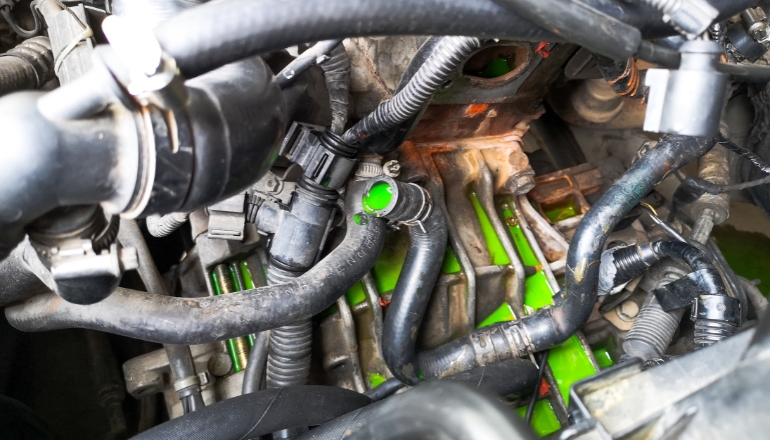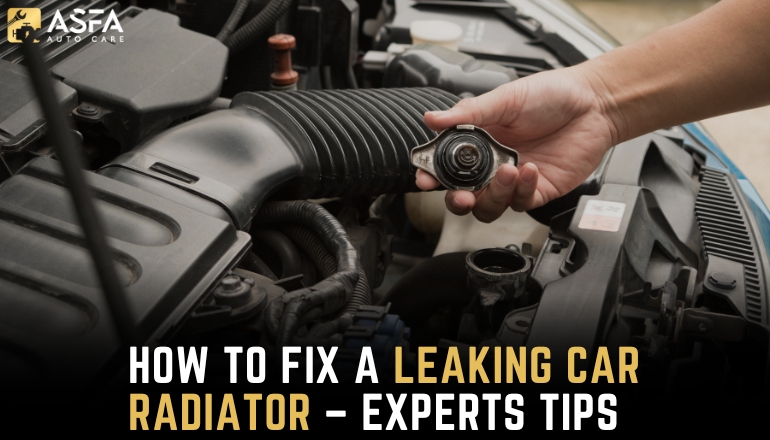A radiator leak is one of the most common issues car owners face. If it is not fixed quickly, it can cause engine overheating and lead to bigger problems. Luckily, most radiator leaks are fixable. Whether it’s a small crack or a loose hose, spotting the signs early and knowing what to do can save you from major repairs.
Your car’s radiator helps keep the engine cool. It sends coolant through the engine, then cools it back down before sending it again. If any part of this system is damaged, coolant can leak.
These leaks often happen because of regular wear and tear. Hoses may crack, and seals can loosen. Sometimes, the radiator itself can get rusty or develop small holes. Overheating, old coolant, and lack of regular car radiator service can also lead to leaks.
Signs You May Have a Radiator Leak
Car radiator leaks often start small and show early signs if you know what to look for. Paying attention to your vehicle’s behaviour can help you detect these problems early and save you from costly repairs. Below are the most common symptoms of a radiator leak:
- Coolant on the Ground: If you see a green, pink, or orange fluid under your car, it’s likely coolant leak from radiator. That’s one of the first signs of a leak.
- Low Coolant Levels: If you keep adding coolant every few days, there might be a slow leak somewhere.
- Car Overheating: When coolant leaks out, the engine can’t stay cool. This leads to car overheating symptoms, like a rising temperature gauge or steam from under the hood.
- Sweet Smell: Coolant has a sweet smell. If you happen to notice this around the engine or inside the cabin, a leak may be the cause.
Step-by-Step Procedure to Fix a Radiator Leak

Not all radiator leaks need major tools to fix them. Some of them can be fixed at your home without going to a radiator repair shop, if you know what to look for and how to fix them. Here is a procedure that you can follow to find the problem and fix it:
Step 1: Let the Engine Cool Down
Before doing anything, wait for the engine to cool because opening the radiator cap while the engine is hot can be very dangerous. Let it sit for at least 30 minutes after turning it off.
Step 2: Find the Leak
Check around the radiator, hoses, and clamps. Look for wet spots, cracks, or white marks left by dried coolant. Use a flashlight if needed. Sometimes, the leak is small and hard to spot. If you are not sure where it’s coming from, an auto radiator specialist can do a pressure test to find the exact spot.
Step 3: Try a Temporary Fix
If it’s a minor leak, you can try a radiator stop leak product. These are poured into the radiator and can seal small cracks or holes. They work best as a short-term fix, not a permanent solution. Make sure to read the instructions on the product. Also, keep checking the coolant level regularly if you’re using this method.
Step 4: Replace Damaged Hoses or Clamps
If the leak is coming from a hose, it may need to be tightened or replaced. A radiator hose leak fix is usually simple. Most hoses are held in place by clamps that can loosen over time. Buy a matching hose if it’s damaged. Make sure the new one fits well and is clamped tightly.
Step 5: Repair or Replace the Radiator
If the radiator itself is leaking, it may need to be patched or replaced. Small cracks in plastic tanks can sometimes be sealed with epoxy. But if the damage is severe, a radiator replacement is often the safer option. A trusted radiator repair shop like ASFA Auto Care can guide you on what’s best.
Why Professional Help Matters
Doing basic repairs at home is fine for minor problems. But if you are seeing frequent leaks or overheating, it’s time to visit a mechanic. An auto radiator specialist can run tests, check the car cooling system, and fix problems that may not be visible from the outside. This includes things like:
- Blocked coolant flow
- Failing thermostat
- Water pump issues
- Internal engine coolant leak
Trained mechanics handle everything from small leaks to full car radiator repair and radiator flush services.
How to Prevent Radiator Leaks
Keeping your radiator in good shape helps avoid unexpected issues. Here are some easy tips:
1. Check the Coolant Regularly
Pop the hood of your vehicle and check the coolant level once every few weeks. Top it up if needed and use the type your car’s manual recommends.
2. Get Routine Radiator Flushes
A radiator flush clears out rust, dirt, and old coolant. Over time, these build up and damage the system. Flushing it every 2–3 years (or as recommended) keeps things clean.
3. Inspect Hoses and Clamps
Hoses should feel firm, not soft or cracked. If you see any damage, get them replaced before they cause leaks.
4. Watch for Overheating Signs
The temperature gauge on your dashboard is a good early warning system. If it goes above normal, get your cooling system checked right away.
5. Book Regular Maintenance
Getting a full car radiator service now and then can save you from expensive repairs. Mechanics will spot small problems early, clean the system, and make sure everything runs smoothly.
Drivers can book reliable and affordable radiator service and repair, with the team checking every part of the vehicle’s coolant system to keep your car running safely.
Also read: Car Alternator: Everything You Need To Know (Expert Tips)
Conclusion
A leaking radiator is not something to ignore. Even a small leak can turn into a major problem if left alone. It may lead to engine overheating, reduced performance, and expensive repairs.
Watch out for signs like fluid on the ground, rising engine temperature, or low coolant levels. Tackle minor issues early and get expert help when needed. For reliable car radiator service and repair, contact a trusted mobile car service Adelaide. Their experienced team can handle leaks, flushes, hose replacements, or full radiator replacements—keeping your car cool and dependable.

